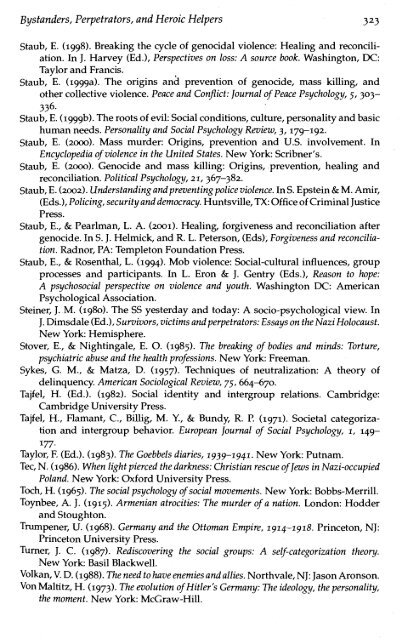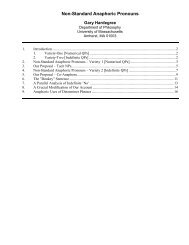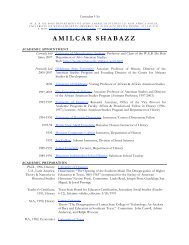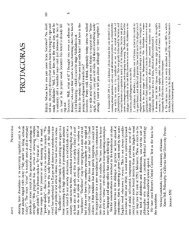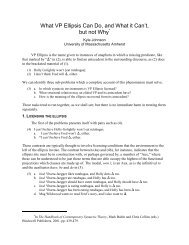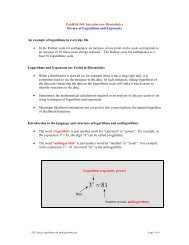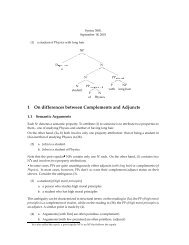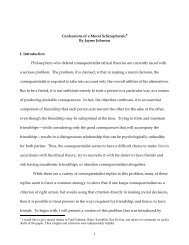The Psychology of Bystanders, Perpetrators, and Heroic Helpers
The Psychology of Bystanders, Perpetrators, and Heroic Helpers
The Psychology of Bystanders, Perpetrators, and Heroic Helpers
Create successful ePaper yourself
Turn your PDF publications into a flip-book with our unique Google optimized e-Paper software.
<strong>Byst<strong>and</strong>ers</strong>, <strong>Perpetrators</strong>, <strong>and</strong> <strong>Heroic</strong> <strong>Helpers</strong> 323<br />
Staub, E. (1998). Breaking the cycle <strong>of</strong> genocidal violence: Healing <strong>and</strong> reconciliation.<br />
In J. Harvey (Ed.), Perspectives on loss: A source book. Washington, DC:<br />
Taylor <strong>and</strong> Francis.<br />
Staub, E. (iggga). <strong>The</strong> origins <strong>and</strong> prevention <strong>of</strong> genocide, mass killing, <strong>and</strong><br />
other collective violence. Peace <strong>and</strong> Conflict: Journal <strong>of</strong> Peace <strong>Psychology</strong>, 5, 303-<br />
336-<br />
Staub, E. (igggb). <strong>The</strong> roots <strong>of</strong> evil: Social conditions, culture, personality <strong>and</strong> basic<br />
human needs. Personality <strong>and</strong> Social <strong>Psychology</strong> Review, 3,179-192.<br />
Staub, E. (2000). Mass murder: Origins, prevention <strong>and</strong> U.S. involvement. In<br />
Encyclopedia <strong>of</strong> violence in the United States. New York: Scribner's.<br />
Staub, E. (2000). Genocide <strong>and</strong> mass killing: Origins, prevention, healing <strong>and</strong><br />
reconciliation. Political <strong>Psychology</strong>, 21,367-382.<br />
Staub, E. (2002). Underst<strong>and</strong>ing <strong>and</strong> preventing police violence. In S. Epstein & M. Amir,<br />
(Eds.), Policing, security <strong>and</strong> democracy. Huntsville, TX: Office <strong>of</strong> Criminal Justice<br />
Press.<br />
Staub, E., & Pearlman, L. A. (2001). Healing, forgiveness <strong>and</strong> reconciliation after<br />
genocide. In S. J. Helmick, <strong>and</strong> R. L. Peterson, (Eds), Forgiveness <strong>and</strong> reconciliation.<br />
Radnor, PA: Templeton Foundation Press.<br />
Staub, E., & Rosenthal, L. (1994). Mob violence: Social-cultural influences, group<br />
processes <strong>and</strong> participants. In L. Eron & J. Gentry (Eds.), Reason to hope:<br />
A psychosocial perspective on violence <strong>and</strong> youth. Washington DC: American<br />
Psychological Association.<br />
Steiner, J. M. (1980). <strong>The</strong> SS yesterday <strong>and</strong> today: A socio-psychological view. In<br />
J. Dimsdale (Ed.), Survivors, victims <strong>and</strong> perpetrators: Essays on the Nazi Holocaust.<br />
New York: Hemisphere.<br />
Stover, E., & Nightingale, E. 0. (1985). <strong>The</strong> breaking <strong>of</strong> bodies <strong>and</strong> minds: Torture,<br />
psychiatric abuse <strong>and</strong> the health pr<strong>of</strong>essions. New York: Freeman.<br />
Sykes, G. M., & Matza, D. (1957). Techniques <strong>of</strong> neutralization: A theory <strong>of</strong><br />
delinquency. American Sociological Review, 75,664470.<br />
Tajfel, H. (Ed.). (1982). Social identity <strong>and</strong> intergroup relations. Cambridge:<br />
Cambridge University Press.<br />
Tajfel, H., Flamant, C., Billig, M. Y., & Bundy, R. P. (1971). Societal categorization<br />
<strong>and</strong> intergroup behavior. European Journal <strong>of</strong> Social <strong>Psychology</strong>, 1, 149-<br />
177-<br />
Taylor, F. (Ed.). (1983). <strong>The</strong> Goebbels diaries, 1939-1941. New York: Putnam.<br />
Tec, N. (1986). When light pierced the darkness: Christian rescue <strong>of</strong> Jews in Nazi-occupied<br />
Pol<strong>and</strong>. New York: Oxford University Press.<br />
Toch, H. (1965). <strong>The</strong> social psychology <strong>of</strong> social movements. New York: Bobbs-Merrill.<br />
Toynbee, A. J. (19x5). Armenian atrocities: <strong>The</strong> murder <strong>of</strong> a nation. London: Hodder<br />
<strong>and</strong> Stoughton.<br />
Trumpener, U. (1968). Germany <strong>and</strong> the Ottoman Empire, 1914-1918. Princeton, NJ:<br />
Princeton University Press.<br />
Turner, J. C. (1987). Rediscovering the social groups: A self-categorization theory.<br />
New York: Basil Blackwell.<br />
Volkan, V. D. (1988). <strong>The</strong> need to have enemies <strong>and</strong> allies. Northvale, NJ: Jason Aronson.<br />
Von Maltitz, H. (1973). <strong>The</strong> evolution <strong>of</strong> Hitler's Germany: <strong>The</strong> ideology, the personality,<br />
the moment. New York: McGraw-Hill.


